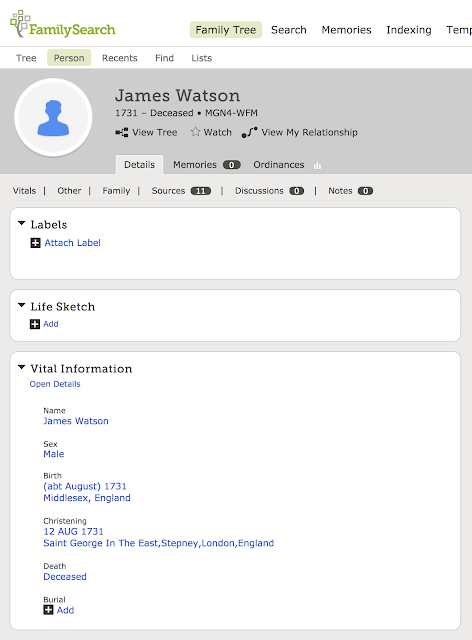Here is this Project's selection.
If you have read any of the previous Project posts, you will know that this example is consistent with what I have been finding regularly on the FamilySearch.org Family Tree. This can almost be reduced to a formula or recipe for fixing the entries. Here we see non-standard entries. In addition, even though this particular entry indicates that there are 11 sources, the family only indicates that there was only one child. This is entirely possible for a variety of reasons including the fact that the mother died in childbirth. The marriage date is interesting because it seems that both the husband and the wife were in their thirties when they got married.
What do I find when I look at the sources?
All of the links to Ancestry.com sources have been added through the Ancetry.com Institutional or Library version so I cannot sign in or view them without going to a Family History Center or library. However, there is a FamilySearch extracted IGI christening record for a James Watson. The problem I see at this point is that the marriage records show a marriage in Westminster, Middlesex and the christening record for the daughter is from Chatham, Kent. Here is the map distance between these two places.
We have to remember that these records are supposed to apply to someone born in the 1700s.
There do not seem to be any duplicates at this point, but I need to do some research about this family. Unfortunately, I immediately find seven or more men named James Watson with marriage records in the same time period in exactly the same parish. This means that I need to start with the daughter, supposedly named Mary Ann Watson. By the way, she is my 5th Great-grandmother.
Clean up time again. But we do jump to having 15 sources attached. There is some inconsistency in the sources with one from Leicester that doesn't seem to belong, but the rest are consistent that this family lived in Chatham, Kent, England. So now, I suspect that we have the wrong James Watson and Ann for the parents of Mary Ann Watson.
Hmm. In a search for "James Watson" in Chatham, Kent, I find 212 results. As I narrow down the search on Findmypast.com by guessing a birth date, I find that there is a James Watson in Medway, Kent who got married in 1747 to one of four women, two of which are named Ann. Not much help at this point. Additional research indicates that there are a large number of men named James Watson and finding one who could have been born in Kent does not produce any possible candidates.
In this case, the solution is to focus on Mary Ann Watson. This Project will have to go into the "long-term" pile of things to do. It is important not to get hung up on researching one person or family that turns into a mess. It is best to spend some time and come back to the research after a while with a fresh look.
Part of doing research is knowing when to stop for a while.
Explanation of how this project began and why I am pursuing it.
Now, after I got going doing the research, I got a couple of requests to research some people further back in time. These turned out to be old, established "end-of-line" situations. Since my original idea was to demonstrate finding people, I started with easier challenges. But in any event, I may or may not find new people to add to the FamilyTree. Since the families I choose are in an "end-of-line" sort of situation independent of the time frame, there is no guarantee that I will be any more successful than the average user of the Family Tree in finding additional family members. In any event, I hope that my efforts as recorded will help either the family members or others to find more information about their ancestral families and relatives.
Why am I doing this? For the past 15 years or so, I have been helping hundreds (thousands?) of people find their ancestors. I simply intend to document the process in detail with real examples so that you can see exactly how I find family lines. I simply want to show where those "green icons" come from. Since the FamilySearch.org Family Tree is entirely cooperative, I will simply assume that when I find a family that needs some research that I am helping that family. By the way, this is Project Five of the series because I intend to do this over and over with different examples.
There is another reason why I am doing this. Because I constantly offer to help people find their ancestors and I get relatively few that take advantage of that offer. I need to spend some of my excess energy.









that's too bad that others aren't taking you up on your offer. Personally, I'd take any help offered :)
ReplyDelete